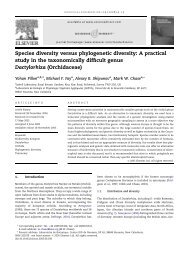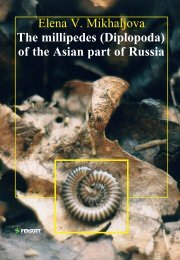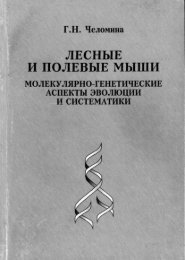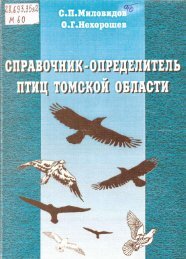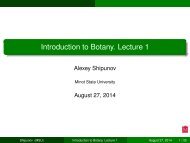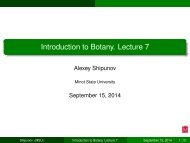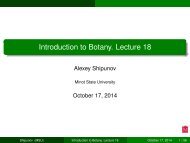PDF - Materials of Alexey Shipunov
PDF - Materials of Alexey Shipunov
PDF - Materials of Alexey Shipunov
Create successful ePaper yourself
Turn your PDF publications into a flip-book with our unique Google optimized e-Paper software.
Wulfenia 10 (2003): 51–59Mitteilungen desKärntner BotanikzentrumsKlagenfurtMorphological leaf-variability <strong>of</strong> West Caucasian He dera L.(Araliaceae) speciesElena A. Kost, Vera S. Rudakova, S<strong>of</strong>ia A. Volkova & <strong>Alexey</strong> B. <strong>Shipunov</strong>Summary: Two ivy species from Russia and Ukrainia, Hedera helix and H. colchica, were investigatedto clarify which metric leaf characters are most suitable for distinguishing these species in fieldworkconditions. Multivariate visualisation methods (like principal component analysis and classificationtrees) show that the most practicable characters are the lengths <strong>of</strong> lamina “diagonal”, petiole andinternode. Crimean (“Hedera taurica”) populations do not differ significantly from Caucasian H.helix.Zusammenfassung: Wir untersuchten zwei Efeu-Arten aus Russland und der Ukraine, Hedera helix undH. colchica, um herauszufinden, welche Blattmerkmale sich am ehesten dazu eignen, diese beidenArten bei der Feldarbeit zu unterscheiden. Multivariate Methoden zeigen, dass die Länge derDiagonale der Lamina sowie die Längen von Blattstiel und Internodium die am besten geeignetenMerkmale sind. Populationen der Halbinsel Krim (H. taurica) unterscheiden sich nicht signifikantvon H. helix-Populationen aus dem Kaukasus.Keywords: Hedera helix, Hedera colchica, Hedera taurica, Araliaceae, leaf characters, morphometrics,determinationTwo ivy (Hedera L.) species are growing in South Russia and the Ukraine: Hedera helix L. andH. colchica (C. Koch) C. Koch. Some authors accept a third species, H. taurica Carr. forCrimean plants (RUBTSOV, 1972). Usually, it is very hard to distinguish these species from eachother. The situation is related with a high variability <strong>of</strong> leaf shapes and sizes, which arecommonly used for determination. Another characters to distinguish ivy species are thenumber <strong>of</strong> chromosomes [H. helix 2n = 48, H. colchica 2n = 192] (VARGAS et al. 1999), smell[pungent and nutmeg-like] (ZERNOV 2002) and the structure <strong>of</strong> leaf trichomes [stellate orplate-like] (LUM & MAZE 1989; ACKERFIELD 2001; ACKERFIELD & WEN 2002). Unfortunately, allmentioned characters are more or less unsuitable for fieldwork. So the goal <strong>of</strong> ourinvestigation was to find out some optimal metric characters which can be used fordetermination <strong>of</strong> these species during field observations.<strong>Materials</strong> & MethodsThe analysed material was collected in the Krasnodar region <strong>of</strong> Russia (Tuapse and Big Sochidistricts) and Crimea. Only these regions <strong>of</strong> European Russia and the Ukraine have warmtemperate weather conditions. The work was carried out in spring 2002 and 2003. Weinvestigated 8 localities in Caucasus and 20 localities in Crimea. Totally 346 leaves weremeasured. Most characters (except structure <strong>of</strong> trichomes) were measured during fieldwork.Ivy has at least three types <strong>of</strong> shoots: (1) vegetative, ground-based; (2) vegetative, trunk-basedand (3) generative. Shoots with long and short internodes also exist, but we used leaves onlyfrom long-internode shoots. On each shoot, leaves periodically change their size from theshoot base upwards: at the beginning <strong>of</strong> each “period” they are small, than they becomebigger and at the end <strong>of</strong> the period smaller again. Such period we called “series” according to
E . A . K O S T E T A L .KRENKEs (1933) point <strong>of</strong> view. We measured all leaves in one (usually top) series from severalshoots in each locality.Figure 1. Main metric characters.The following characters were observed (Fig. 1):(1) TIP.POB: shoot type (0 — ground-based; 1 — trunk-based; 2 — generative);(2) L.MEZHD: length <strong>of</strong> an internode (from the base <strong>of</strong> the petiole), mm;(3) L.CHER: length <strong>of</strong> a petiole, mm;(4) W.LOC: position <strong>of</strong> a greatest width <strong>of</strong> a leaf, mm;(5) DIAG: length <strong>of</strong> the “diagonal” <strong>of</strong> a lamina i.e. the distance from the lamina base pointto the right apical cut, mm;(6) L.MAX: highest length <strong>of</strong> a lamina, mm;(7) W.MAX: highest width <strong>of</strong> a leaf, mm;(8) PARTS: number <strong>of</strong> the leaf lobes;(9) SMELL: smell type from pulverised leaves (pungent or nutmeg-like) and
L e a f - v a r i a b i l i t y o f W e s t C a u c a s i a n H e d e r a s p e c i e s(10) TRICH: structure <strong>of</strong> the trichomes (stellate or plate-like).Besides, we calculated some “secondary” characters which utilise measured ones:(a) L.MAX/L.CHER = relative length <strong>of</strong> petiole;(b) L.MAX/W.MAX = leaf “circularity”;(c) W.LOC/L.MAX = leaf “oblongness” and(d) DIAG/(sqrt(2)*W.MAX) = diagonal fraction, i.e. fraction between “theoreticaldiagonal” (supposing that leaf is round-shape) and real one.Thus we have different group <strong>of</strong> characters:(i) primary metric characters (L.MEZD, L.CHER, W.LOC, DIAG, L.MAX, W.MAX);(ii) categorical ones (SMELL, PARTS, TRICH) and(iii) secondary metric characters.The analysis <strong>of</strong> these multivariate data was performed by means <strong>of</strong> the statistical s<strong>of</strong>tware R(VENABLES & SMITH 2002).Results & discussionAll primary leaf-based characters, petiole length and internode length are correlated to eachother (Spearman r = 0.5–0.8; p < 0.05). PARTS also correlates with most <strong>of</strong> leaf-basedcharacters (r ≈ 0.5; p < 0.05). Unfortunately, SMELL is strongly associated with person whoperforms measurements and hereby this character is very subjective. Further investigationsshowed that most people could recognise pungent smell <strong>of</strong> H. helix, but nutmeg-like smell <strong>of</strong>H. colchica is very hard to distinguish. All leaf characters had low correlations (r < 0.4; p
E . A . K O S T E T A L .Figure 2. Scatterplot <strong>of</strong> two first principal components from first PCA(see text). Numbers correspond with trichome type (1 — stellate, 2 —plate-like).Figure 3. Scatterplot <strong>of</strong> two first principal components from first PCA(see text). Numbers correspond with numbers <strong>of</strong> leaf lobes.
L e a f - v a r i a b i l i t y o f W e s t C a u c a s i a n H e d e r a s p e c i e sFigure 4. Scatterplot <strong>of</strong> two first principal components from first PCA(see text). Numbers correspond with shoot type (0 — ground-based, 1— trunk-based, 2 — generative).Figure 5. Scatterplot <strong>of</strong> two first principal components from secondPCA (see text). Numbers correspond with trichome type.
E . A . K O S T E T A L .Figure 6. Scatterplot <strong>of</strong> two first principal components from third PCA(see text). Numbers correspond with trichome type.Figure 7. Regression tree <strong>of</strong> all primary metric characters according toclassification by trichome type. Each node marked by character value<strong>of</strong> left branch.To explore the overall diversity <strong>of</strong> measured leaves we performed several principalcomponent analyses (PCA). First PCA was performed with primary metric characters,
L e a f - v a r i a b i l i t y o f W e s t C a u c a s i a n H e d e r a s p e c i e sPARTS and TRICH. The resulted classification is relatively clear and generally according withthe distribution <strong>of</strong> TRICH characters (Fig. 2). However, this classification does notcorrespond with the distribution <strong>of</strong> PARTS (Fig. 3). This means that whereas classificationfrom first PCA does not contradict with primary metric characters, PARTS does not play abig role here. The classification does not depend from shoot type (Fig. 4); and all leaves fromone series are placed together. Crimean populations do not differ from Caucasian H. helix, sowe have an argument against a separate species status for Crimean ivy. Analysis <strong>of</strong> principalcomponents’ loadings (Table 1) shows that the biggest loadings in this case have DIAG,L.MAX and L.MEZHD.For proving the role <strong>of</strong> trichome type character we removed it and than repeated the principalcomponent analysis with remained characters. This second PCA, however, cannot returnclear groups (Fig. 5).A third PCA was performed with the set <strong>of</strong> secondary characters. The resulting classification(Fig. 6) is not clear and there are no groups. The TRICH character has much less loading thanin first PCA. This can mean that “classification behaviour” <strong>of</strong> secondary characterscontradicts with TRIH and primary leaf characters and thereby are not suitable forclassification.Discriminant analysis was also performed to elucidate relationships between classification bymetric characters and trichome type. The last two characters were used as classifying variables:Percent <strong>of</strong> correctness (number <strong>of</strong> correct classifications / number <strong>of</strong> objects * 100) in thiscase is relatively large (88.4%). Then we used a recursive partitioning analysis (VENABLES &RIPLEY 2002) to clarify which metric characters are most useful for classification. This analysisusually returns so-called regression trees that correspond with contributions <strong>of</strong> all charactersin classification models. Our tree (Fig. 7) shows that DIAG character plays the mostimportant role in classification: most leaves (92%) having DIAG less than 25.5 mm are leaveswith plate-scale trichomes. Consequently, some metric characters (especially DIAG, L.CHERand L.MEZHD) could be used for diagnostic purposes.ConclusionLengths <strong>of</strong> leaf “diagonal”, petiole and internode are the most perspective characters for fielddetermination <strong>of</strong> Hedera colchica and H. helix.Crimean (“Hedera taurica”) populations do not differ from Caucasian H. helix.Caucasian localities usually contain both groups (Hedera helix and H. colchica). Unfortunately,there is no clear evidence <strong>of</strong> coexistence, hybridisation or introgression between this species.The number <strong>of</strong> leaf lobes does not correspond with a classification by trichome types.Classification by trichome types does not distinguish the different types <strong>of</strong> the shoots.AcknowledgementsWe acknowledge Dr. S. M. Glagolev, A. N. Kvashenko, students <strong>of</strong> the Moscow South-WestHigh School and Dr. A. A. Oskolski (Botanical Institute, St.-Petersburg) for their great help inthis work.References
E . A . K O S T E T A L .ACKERFIELD, J. (2001): Trichome morphology in Hedera (Araliaceae). – Edinb. J. Bot. 58: 259–267.ACKERFIELD, J. & WEN, J. (2002): A morphometric analysis <strong>of</strong> Hedera L. (the ivy genus, Araliaceae) andits taxonomic implications. – Adansonia 24: 197–212.KRENKE, N. P. (1933): Fenogeneticheskaja ismenchivost'. [Phenogenetic variability] – Trudy Biol.instituta im. K. A. Timirjazeva 1: 1–500. [In Russian]LUM, C. & MAZE, J. (1989): A multivariate analysis <strong>of</strong> the trichomes <strong>of</strong> Hedera L. – Watsonia 17: 409–418.Rubtsov, N. I. (1972): Opredelitel' vysshikh rastenii Kryma. [Diagnostic book <strong>of</strong> Crimean higherplants] – Leningrad: Academic Publishers. [In Russian]VARGAS, P., MCALLISTER, H. A., MORTON, C., JURY, S. L. & WILKINSON, M. (1999): Polyploidspeciation in Hedera (Araliaceae): phylogenetic and biogeographic insights based onchromosome counts and ITS sequences. – Pl. Syst. Evol. 219: 165–179.VENABLES, W. N. & RIPLEY, B. D. (2002): Modern applied statistics with S. – New York: SpringerVerlag.VENABLES, W. N., SMITH, D. N. & THE R DEVELOPMENT CORE TEAM (2002): An introduction to R. –Bristol: Network Theory Ltd.ZERNOV, A. S. (2002): Opredelitel' rastenij Severo-Zapadnogo Zakavkaz'ja. [Diagnostic book <strong>of</strong>Northwest Trans-Caucasus plants] – Moscow: KMK Scientific Press. [In Russian]Addresses <strong>of</strong> the authors:Elena A. KostBiological DepartmentMoscow South-West High School27 Bakinskih Komissarov str. 3-5Moscow, 119571Russian FederationE-mail: tuti@rol.ruVera S. RudakovaBiological DepartmentMoscow South-West High School27 Bakinskih Komissarov str. 3-5Moscow, 119571Russian FederationE-mail: bio@s43.msk.suS<strong>of</strong>ia A. VolkovaBiological DepartmentMoscow South-West High School
27 Bakinskih Komissarov str. 3-5Moscow, 119571Russian FederationE-mail: avolkov@orc.ruL e a f - v a r i a b i l i t y o f W e s t C a u c a s i a n H e d e r a s p e c i e sDr. <strong>Alexey</strong> B. <strong>Shipunov</strong>Section <strong>of</strong> Molecular SystematicsJodrell LaboratoryRoyal Botanic Gardens, KewRichmond, Surrey, TW9 3DSUnited KingdomE-mail: a.shipunov@rbgkew.org.uk




